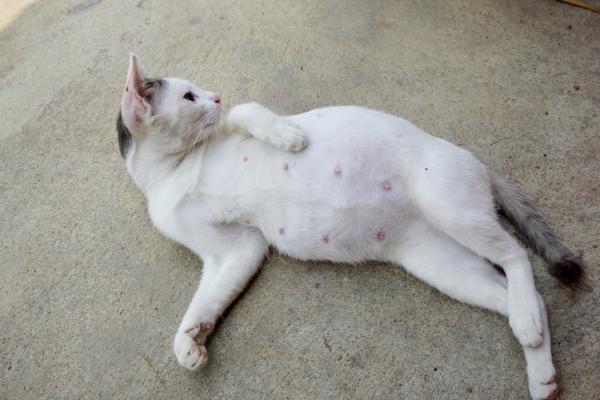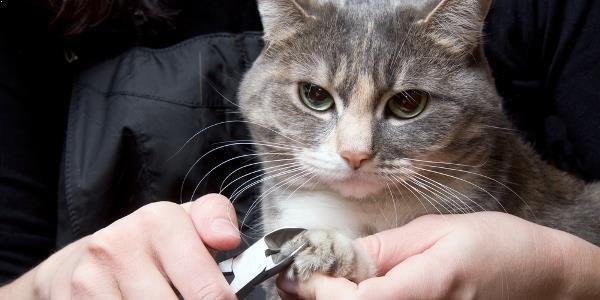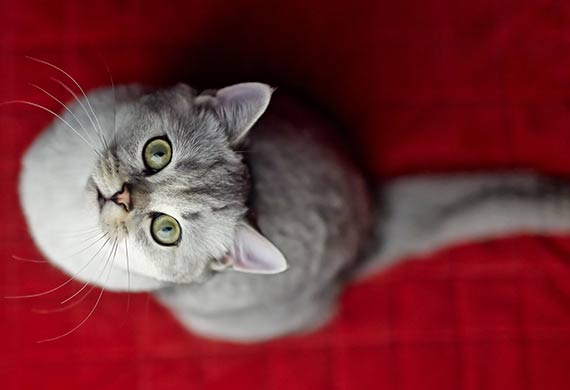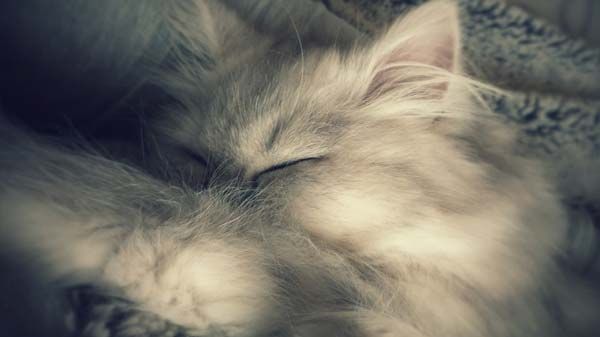In this article by myfriendlypets we are going to talk about how long a cat’s pregnancy lasts so that, if we are facing a state cat, we have an idea of the date by which we should prepare the arrival of the kittens. We will also explain how we will be able to know, approximately, how long a cat is pregnant, how we will identify the pregnancy, or how many kittens she can give birth to. It is important that we consult with our veterinarian so that we can be properly monitored.

After delivery, it is advisable to evaluate the option of castrating or sterilizing the cat to avoid another litter in the future, since, as we will see, cats can give birth several times a year. Read on and discover the duration of a cat’s pregnancy.
Pregnancy test for cats
Before discussing the duration of a cat’s pregnancy, it must be confirmed that she is indeed pregnant. For this, the most recommended is to visit the vet, since by means of ultrasound we will know if there really is pregnancy and how many kittens it will have. Likewise, there are pregnancy tests on the market for cats that use urine to obtain a result.
On the other hand, the symptoms of pregnancy in cats will also help us check if she is really pregnant. The most common are:
- Belly bulging.
- Swollen breasts.
- Changes in your behavior.
- More hours of sleep.
- Nest preparation.
Duration of a cat’s pregnancy
Cats can spend a good part of the year in heat, as this is related to sunlight. During this period they will be able to be mounted by males who, after copulation, by removing their penis covered in spicules, induce ovulation. Due to the long duration of heat, we will have high fertility in cats.
If we collect any of more than 6 months, which is the age at which their jealousy usually begins, and we have confirmed that they are pregnant, we must provide veterinary assistance throughout the pregnancy to check that everything is working correctly. For this, it is important that we know how long a cat’s pregnancy lasts, both to set an approximate date of delivery and to calculate the visits to the specialist that will be necessary. A cat’s pregnancy usually lasts one-two months (58-67 days), both in first-time cats and in successive pregnancies. We will see, below, other relevant aspects.
How do I know how pregnant my cat is?
We have put the length of a cat’s pregnancy at about eight weeks. If our cat was in heat and this is interrupted we can think that the pregnancy has taken place, although in the first weeks we are not going to appreciate any significant change in it that makes us suspect that it is in a state. If we think you may be pregnant, by 20 days our vet may detect it with an ultrasound. If the pregnancy is not desired it can be interrupted at this time. Although some veterinarians perform ovariohysterectomies at any time during pregnancy, operating with an advanced pregnancy increases the risks.
Towards the middle of the pregnancy we will be able to notice among the main symptoms of pregnancy that the abdomen of the cat has increased in size. If we have not done this before, we must feed the mother with a specific feed for growing kittens because it will be the one that meets her new nutritional needs, or follow a homemade diet with the advice of a veterinarian specialized in nutrition. This sign may indicate that the cat is about four or five weeks pregnant.
At the end of pregnancy, if we put our hands on both sides of the abdomen, we may notice the movement of the kittens. The breasts will enlarge in preparation for breastfeeding. The search for a quiet place, a decrease in appetite or the appearance of vaginal discharge are signs that labor is imminent. Looking at these data will help us determine how much our cat is pregnant, which will be around seven weeks of gestation.
Symptoms of childbirth in cats
As we have mentioned, the delivery will take place about two months of gestation. At this time, the cat will go to the nest that she has prepared and will begin to show the following symptoms:
- You will be restless and your breathing may speed up.
- A brown or bloody vaginal discharge will appear.
- The vulva will be constantly licked.
- It will show visible signs of contractions, such as abdominal movements or heavy breathing.
- It will start to push to expel the first kitten.
If we observe these symptoms, in principle, our intervention should not be necessary. However, we can stay close to check that everything is going well and the little ones start to eat.
How many cats can a cat give birth to?
We have said how long a cat’s pregnancy lasts, so at the end of the two months we must wait for the birth. In general, as we have indicated, the cats stop alone without complications and we should only leave them alone. Even so, we must be vigilant and with the veterinarian’s phone at hand in case any problem arises during the delivery of the cat.
On how many cats a cat can give birth there is no fixed number. The average is four, but this figure can range from 1 to 5 kittens. If the veterinarian has determined during gestation the number of fetuses, after delivery we must count that they are all. If the number does not match we will have to notify you.
How many times a year do cats stop?
In the same year, if we do not prevent it, the cat can return to have offspring, with the obligation that this implies when sending them all to responsible homes. Given the high number of homeless cats, the option is undoubtedly spaying.
Up to what age can a cat give birth?
The truth is that there is no age limit for all cats. Depending on the race and lifestyle you have led, it can reproduce for more or fewer years. There are cats that can give birth up to 10 years old while others do so until 17. What is important to know is that continued litters can seriously harm the cat’s health, shortening her life expectancy. For this reason, we again insist on sterilization.
Zeal of cats
The cats reach sexual maturity when they present their first heat, which is usually between 6 and 9 months of age. From this moment, the following periods of heat will be determined, mainly, by sunlight. This is so because cats are seasonal polyester. Cats, on the other hand, mature sexually between 8 and 12 months approximately. From then on, they can go into heat all year round, since for them it is activated when they perceive the smell of a cat in heat.
Now, that a cat or cat reaches sexual maturity does not mean that it is prepared to mate. It is true that physically they can already reproduce and have offspring, but they are still too young to do so. Likewise, it is important to keep in mind the number of cats abandoned on the street or living in shelters waiting to find a new home. For all these reasons, we recommend opting for castration or spaying in order to avoid unwanted litters, since we have already seen in the previous sections that a female can give birth several times a year, for many years.
After giving birth to a cat, when does she go into heat?
Not all cats go into heat at the same time after giving birth. Some take about six months to start the heat period again, while others do so just a few weeks after delivery. Thus, a cat could become pregnant again one or two weeks after giving birth.
The sterilization of a cat
The cats are seasonal polyester, which means that during the months of more sunlight, generally from the end of winter to the beginning of autumn, they will be continuously jealous, only slowed down if fertilization occurs.
Knowing how long a cat’s pregnancy lasts, it is easy to calculate that it can give birth to more than one litter a year and, taking into account the beginning of sexual maturity, all these kittens will be reproducing the following year. Making calculations we will understand the importance of sterilization. This surgery can be performed before the first heat and, in addition to controlling birth, it has health benefits, such as avoiding uterine infections or, to a large extent, breast tumors.





